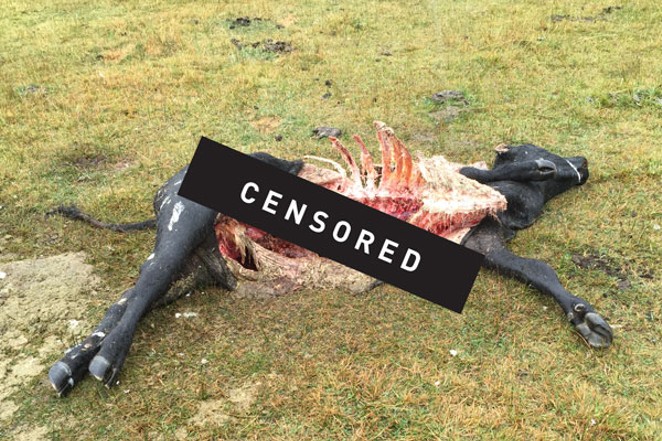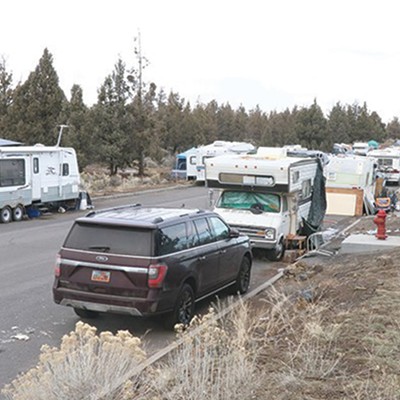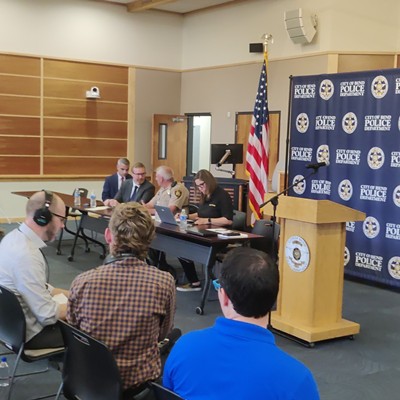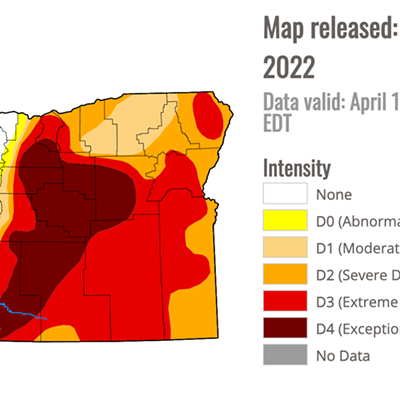A heavy fog settled over the pastures of the Nicholson Ranch in the Wood River Valley, making it nearly impossible to see the herd of cattle grazing nearby.
Only a few days before, trauma hit these private lands near Fort Klamath, owned by 4th generation rancher Bill Nicholson. In summer, Nicholson leases his pastures to outside cattlemen who use it to range their herds, allowing the cattle to gain 3 to 4 pounds a day grazing on the nutrient-rich grass. This particular visit took place just days after wildlife biologists confirmed that wolves had killed four healthy steers. As Nicholson drove his truck through the pastures located just south of Crater Lake National Park, he pointed out the exact locations where each animal was killed. "Those were the first confirmed wolf kills that we've had," he says.
The wolves are part of the Rogue pack which was established in recent years when a wolf designated as OR 7 wound its way from northeast Oregon, found a mate, and established the pack. Today, wildlife officials think there are up to seven uncollared wolves in the pack, making it difficult to track their movement and location and to keep them away from cattle.
The Grim Discovery
Ranch manager Butch Wampler discovered the kills after starting to see wolves in mid September. On Oct. 2 he found a dead 800-pound steer and noticed a wolf running away. A second wolf was also spotted, and a day later he noticed three wolves feeding on the carcass. On Oct.4, he found another 600-pound steer dead.
While on his night rounds on Oct. 5 he noticed something was wrong. He was searching for a bawling calf that sounded distressed, but he couldn't find it. "There were 50-60 head in a big circle just standing there. That wasn't right for all those cattle to not be bedded down at that time of night," he states. The cattle were being stalked by wolves and had formed a protective circle.
The next morning he found the 458-pound calf with deep wounds in its legs. It later died. A fourth dead steer was found two days before the Source Weekly toured the ranch on Oct. 21 with a frustrated Nicholson. "Being an endangered species, our hands are tied when trying to watch our cattle," he said. The wolf is considered endangered in nearly two-thirds of the State of Oregon and federal protections carry severe penalties if a wolf is purposely killed – even by a rancher trying to protect cattle on private land.
The killings aren't clean and quick. A kill can take hours as wolves separate their prey and begin biting until the animal goes into shock. Once down, the wolves begin ripping into the animal's organs. Wampler says cattlemen need to be able to protect their herds. "I think there should be controlled hunts, because if you don't, how are you going to slow them up from killing these cattle?"
Nicholson adds, "I think our ancestors were right when they got rid of them. The wolf is one of the more predatory animals in the wild, for crying out loud. They decimate our deer and elk and now, obviously, cattle."
Wolves were reintroduced in Yellowstone National Park in 1995. Oregon State University studies suggest there have been riparian enhancements since the reintroduction. The presence of wolves are allowing young cottonwood trees, for one, to thrive along stream banks where they were once decimated by elk herds.
Erik Fernandez of Oregon Wild in Bend is a strong supporter of the reintroduction of wolves, believing that wolves are a minimal threat to cattle. "There are 1.3 million cows in Oregon. 55,000 annually die from things like disease and bad weather. Most years there are about 40 depredations by wolves." Fernandez also favors non-lethal controls. "There is a lot we can do with non-lethal to avoid problems, but there isn't much we can do to change the fact that some ranchers just don't like wolves."
Managing Wolves
John Stephenson of the Bend office of the U.S. Fish & Wildlife Service coordinates the federal wolf management program in Oregon. He says he has no current plans to lethally eliminate the wolves responsible for the killings and prefers to haze them to keep them away from herds.
Hazing includes the use of nighttime strobe lights, special flagging on fence lines and patrols. Stephenson has also set traps in an effort to capture and collar the wolves, but Nicholson and Wampler aren't convinced that the efforts work. Pointing to the location of a strobe light hooked to a fence, Wampler says one of the kills occurred only 100 yards away.
Nicholson scoffed, "I don't think it's gonna work at all."
While most of the cattle have been trucked out of the Wood River Valley for the winter, Nicholson worries about next summer. "I think this valley here will be a smorgasbord. We're gonna have 35,000 head of cattle here enclosed in a valley six miles wide and 12 miles long. We could have half a dozen packs that hang around here because of the easy pickings."
Conservationist and hunter Karl Findling, who accompanied the Source Weekly on the Nicholson ranch tour, states, "They're gonna prey on domestic cattle like they're candy!" Findling says there is a place for wolves on the landscape, but he feels their populations will eventually have to be managed in a balanced manner as more packs form and populations continue to grow.
The USFWS's Stephenson thinks Oregon will likely follow trends seen in other western states such as Idaho where wolf populations are much greater. No longer considered endangered, Idaho wolves are managed as big game species with a hunting season and an annual hunting derby. "We do expect the population to grow. It's growing pretty rapidly," says Stephenson.
Stephenson says wolves will probably, eventually, be removed from the endangered species list, allowing the state to manage the population, including the ability to use lethal means if necessary. "The pattern in other states that have had wolves longer than we've had is as the population grows they've decided to have a harvest to maintain populations. For ranchers, it won't be too long before they have more tools to deal with these problems."
Endangered Status
In late 2015, the State of Oregon decided to de-list the wolf as endangered based on population counts. The Oregon Department of Fish & Wildlife stated there were 110 wolves statewide at that time, and the agency expects populations to grow to 300 in three to five years. However, federal protections still exist for wolves west of Highway 395 in Eastern Oregon, often leading to some confusion.
Where there are no federal protections, such as in Northeast Oregon, the state can use lethal means to control wolves if necessary. But where there are federal protections, only the U.S. Fish & Wildlife Service has authority to kill wolves where conflicts with cattle lead to repeated depredations. The state used lethal means to eliminate four problem wolves in Northeast Oregon last spring.
Planning For the Future
Oregon is now updating its Wolf Management Plan. The first plan was adopted in 2005, when only a handful of wolves had crossed the Snake River from Idaho after being reintroduced in Yellowstone National Park. The Oregon Department of Fish & Wildlife is required to review its plan every five years to determine what is working and how to improve the plan. A recent meeting was held in La Grande where more than 50 people testified during an informational meeting. Among the issues under review are whether there should be controlled hunts and whether the state should create local wolf management zones to control them.
The Union County Cattlemen's Association suggests creating management zones for wolves. A safe zone would create the most protection. Harassment zones would create areas where they can be chased, trapped and hazed in an effort to mitigate cattle conflict. Zones for private land, cities or towns would be created where wolves could be controlled by any means necessary to avoid conflict.
An updated draft plan will be submitted to the Oregon Department of Fish & Wildlife commission in December. The commission is expected to vote on the update in 2017. Some observers say the wolf management zones may be premature and that populations need to increase and stabilize before they should be considered.
Hunting Wolves
An all-out recreational hunting season for wolves such as the one in Idaho would be "absurd," according to Oregon Wild's Fernandez. "We would be highly skeptical of any hunting ODFW initiates just because wolves are not popular with some people," he says. Still, Fernandez leaves the door open for some hunting when wolf populations reach higher levels where they can be sustained. "If we get to a point where there are wolf packs well distributed throughout Oregon, and good genetic exchange with other populations around the region, then we would be more open to hearing arguments for recreational hunting. But we are nowhere near that point now."
A recent poll commissioned by the Pacific Wolf Coalition made up of conservation groups and conducted by Mason-Dixon Polling & Research of Washington, D.C. found that 67 percent of Oregonians oppose hunting wolves as a means to protect deer and elk, and 72 percent oppose trophy hunting of wolves.
Seventy-two percent of respondents approve of killing wolves responsible for repeated livestock attacks, and 74 percent favor compensating ranchers for livestock losses. A taxpayer-funded compensation plan has been in effect, but often it takes months of review and paperwork before reimbursement.
According to the Oregon Department of Agriculture, beef and calves are the state's leading commodity valued at nearly $1 billion. For ranchers like Nicholson and his manager Wampler, more flexible means of managing wolves on private land can't come soon enough. Wampler sums it up from the ranchers' perspective: "The people that own these cattle are in it to make money, not to feed wolves."
Want more of this story? Check out Brian Jennings' podcast version:
Sierra Club Presents Wolf OR-7 Expedition, a documentary
WHEN Thursday, November 10, 6:00 PM
WHERE Unitarian Universalist Fellowship, 61980 Skyline Ranch Road, Bend
WHAT An ordinary Oregon wolf became famous as the wandering wolf called OR-7. Thanks to OR-7's GPS collar we can retrace his path through eastern and central Oregon's mountain, canyon and desert landscapes. This documentary features six adventurers who embark on an expedition, by foot and bicycle, to cover 1200 miles of OR-7's journey—giving us fascinating insight into how and where this wolf made his way through lands wolves once called home.
PURCHASE Tickets available at Eventzilla, at the door, or by check.
COST $20 adults, $10 Youth 18 and under (use code SC-18)
CONTACT Gretchen Valido, 541-389-0785, [email protected]



























